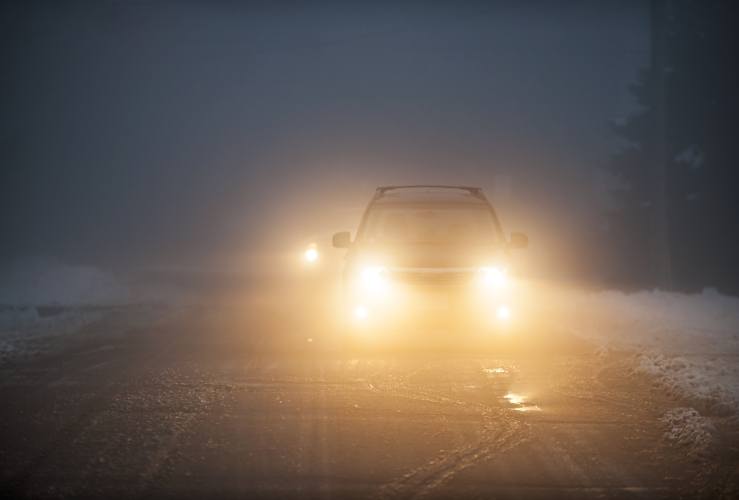Driving in fog self-evidently makes it much harder to see road users and other hazards. There are specific rules for driving in fog in the UK - and governing the use of fog lights.
Rule 226
If visibility is seriously reduced, you are required to use your headlights. If you cannot see further than 100m (328 feet), visibility is considered poor.
Rule 236
If you have front or rear fog lights you should only use them in poor visibility - and turn them off as soon as conditions improve.

Driving in the fog: safety advice
Avoid unnecessary delays
If heavy fog is present or is forecast in your area, consider postponing your journey until conditions improve. This is the simplest way to avoid the hazards of driving in fog.
Ensure your headlights are working properly
Check both front and rear lights are working properly on both sides. Ensure they are set to dipped beam which will help you see more on the road - and help other road users see you.
Your vehicle may have automatic headlamps: make sure they are on, consider overriding them in favour of manual control. Full beam should be avoided since the light can reflect off the fog and make visibility worse.
You'll know your full beams are on if you see a small blue headlight icon on your dashboard. If you see this, turn off your full beams.
Only use fog lights when visibility is under 100m (328ft)
What is the fog light symbol?
Learn how to turn on your rear fog lights, indicated with an orange, lamp-shaped symbol. These will only work if your main headlights are also on. Front fog lamps are indicated with a green lamp-shaped symbol featuring sloping straight lines and a wavy line.
You should only use front and/or rear fog lamps when visibility is under 100m, and you should turn them off as soon as visibility improves - since they could dazzle other road users.
What do fog lights do?
When adverse weather conditions make it difficult for drivers to see the road ahead, fog lights help improve visibility. Due to their lower mounting on the front of the car, fog lights can penetrate mist, fog, rain and even dust.
What happens if you use rear fog lights in good conditions?
Having rear fog lights in good weather conditions can obscure your brake lights and prevent drivers behind you from realizing you are braking. So why is it dangerous to leave your fog lights on in good visibility?
When there is good visibility, both front and rear fog lights also cause unnecessary glare that can annoy other road users and dazzle them. Hence, why it is dangerous to leave fog lights on
Reduce condensation with your heater
Condensation can build up quickly in cold or foggy conditions. You can prevent this by turning on your heating system and, if you have them, rear and/or front heated windscreens.
Leave plenty of space between you and the vehicle in front
Being able to see rear lights on the vehicle in front of you can give a false sense of security: keep a safe distance so you have enough time to stop if you need to.
Keep your speed down
It goes without saying that if you keep your speed down, you'll have more time to react if a hazard suddenly appears.
The road ahead may look clear, but that doesn’t mean it is - particularly in very heavy fog.
Fog may turn to ice
In very cold conditions, fog can crystallise into ice - adding another hazard and making it all the more important to reduce your speed.
Turn off the radio/music
Give yourself the best chance of detecting other road users by turning off music - particularly useful at foggy junctions, where you can wind down your window in order to hear oncoming traffic that you may not be able to see.




